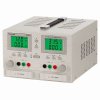Power supply Current limiting , using what value resistor?
The power supply I have has current limiting knobs but it doesn't show you how much current it is outputting until you hook it up to the circuit
I want to know BEFORE i hook it up to the circuit how much current is outputting out of the external power supply
For some reason the external powers supplies don't tell you how much current is outputting unless its hooked up to a circuit
What value resistor and how many watts do I need?
A circuit board I'm working on has Mercury Relays that are dirty with corrosion, What can I use to clean the mercury contacts on the relays? they are from the 60's these relays
The power supply I have has current limiting knobs but it doesn't show you how much current it is outputting until you hook it up to the circuit
I want to know BEFORE i hook it up to the circuit how much current is outputting out of the external power supply
For some reason the external powers supplies don't tell you how much current is outputting unless its hooked up to a circuit
What value resistor and how many watts do I need?
A circuit board I'm working on has Mercury Relays that are dirty with corrosion, What can I use to clean the mercury contacts on the relays? they are from the 60's these relays
Last edited by a moderator:



